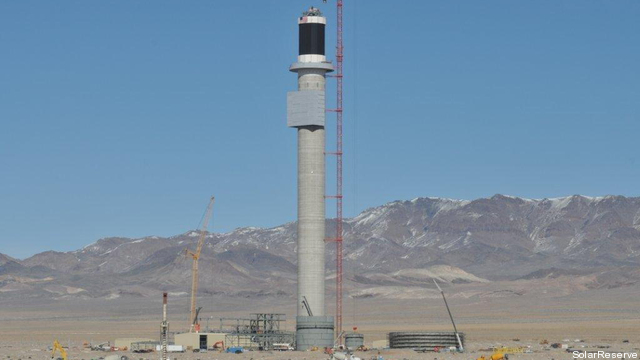Companies and engineers worldwide are pursuing grid-scale energy storage technology that would allow distributed renewable energy sources to easily and efficiently feed electricity into centralized power grids. Once economically commercialized, such technology would find a gargantuan market. And a US-based company will jump ahead of the competition next year with its molten salt storage technique.
“This technology at this size would leap-frog us into [energy] storage leaders,” Solar Reserve CEO Kevin Smith recently told Breaking Energy.
The California-based, PE-backed startup launches its flagship 110 MW concentrated solar power (CSP) project known as Crescent Dunes next year in the Nevada desert. The technology uses a tower-based approach where thousands of mirrors focus sunlight onto a single point to create heat that generates steam used to spin an electricity-producing turbine. First power to the grid is expected mid-2014.
Solar Reserve has a 25-year power purchase agreement with Nevada Energy, a utility. The power will most likely be used during off-peak hours, said Smith. “This will be the first commercial-scale CSP project with storage,” he said.
Solar Reserve licensed the technology from aerospace firm Rocketdyne, which was recently sold by Pratt & Whitney to GenCorp subsidiary Aerojet.
Solar Reserve competitor BrightSource also uses a tower-based design for its Ivanpah CSP project in California, but energy storage is not a major component of that technology. When fully online Ivanpah will be the world’s largest CSP plant, taking a title briefly held by the Shams 1 CSP plant in Abu Dhabi.
Read more Breaking Energy coverage of Shams 1 here and here. You can read more about the technology being employed at Crescent Dunes here.
Solar Reserve has another licensed and permitted project in California, known as the Rice project that will use molten salt storage with 150 MW of solar power generation capacity. “We are trying to arrange financing and the tax equity investment portion now,” said Smith.
The US regulatory environment is somewhat uncertain with regard to the longevity of tax-based renewable energy project incentives. As a result, Smith said Solar Reserve is very active in both CSP and photovoltaic technology internationally, where the growth potential is “tremendous.”
“We’re looking at projects in Chile, Saudi Arabia and Qatar, and have offices in Perth, Dubai, Santiago, Johannesburg, Madrid and Turkey,” Smith said.
“If you look at the Saudi Arabian program and the one in Qatar, they are looking to meet domestic power demand, which frees up oil for export. The Saudis are looking to replace a substantial amount of oil for power generation and it’s similar in Qatar where they’re looking to generate power with solar to free up natural gas for export, said Smith.
“When the Saudis announced a $120 billion solar project people said why, they have so much oil? But they want to preserve oil reserves for export.”
Read more about the Middle East natural gas crisis on Breaking Energy here.
Storage as a Crucial Component
There is stiff competition to commercialize grid-scale energy storage technology and Smith is proud that US-based technology is at the forefront. “The key for us is the storage story…we’re competing against the Spanish, Germans, Chinese and Israelis, but US technology is leading worldwide,” he said.
“Right now the only alternative to our technology is PV with battery storage, which is not very feasible for large-scale storage. In the energy storage wars molten salt is the only viable technology right now. The California Public Utility Commission just passed a requirement for 1,300MW of energy storage by 2020 and this technology will help PG&E meet that requirement.”
“Most of the bids we are looking at in Saudi Arabia, Chile, Morocco and South Africa are all requiring energy storage,” said Smith.

